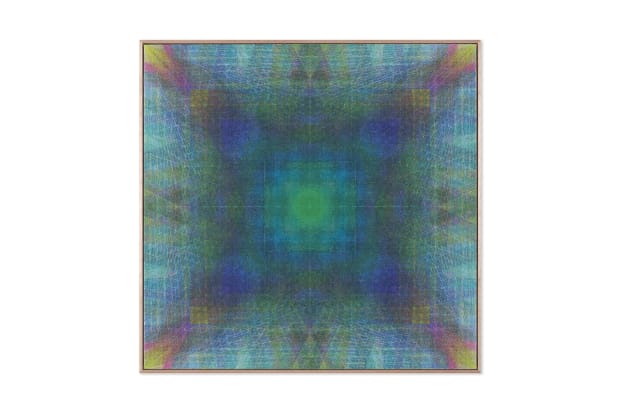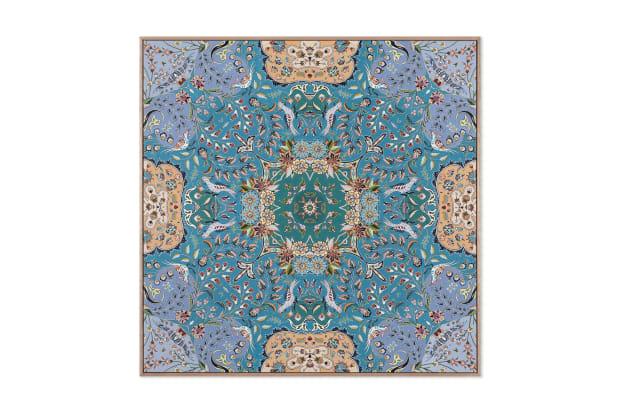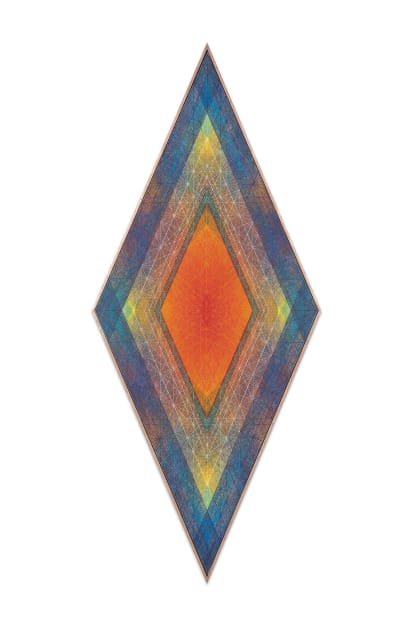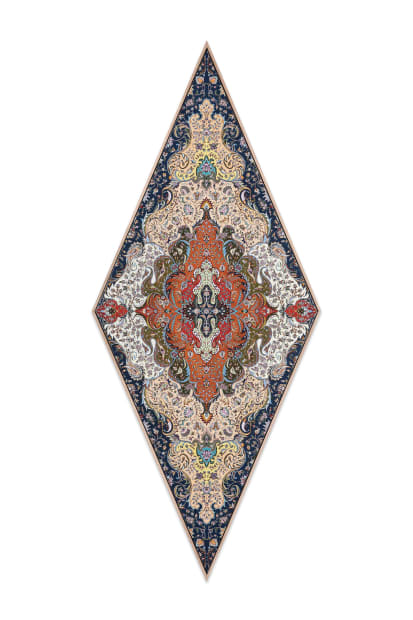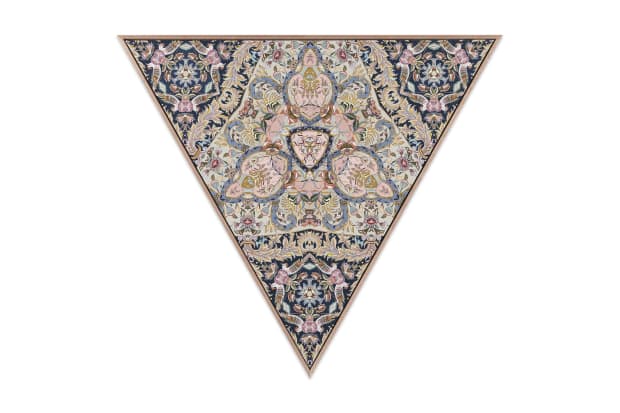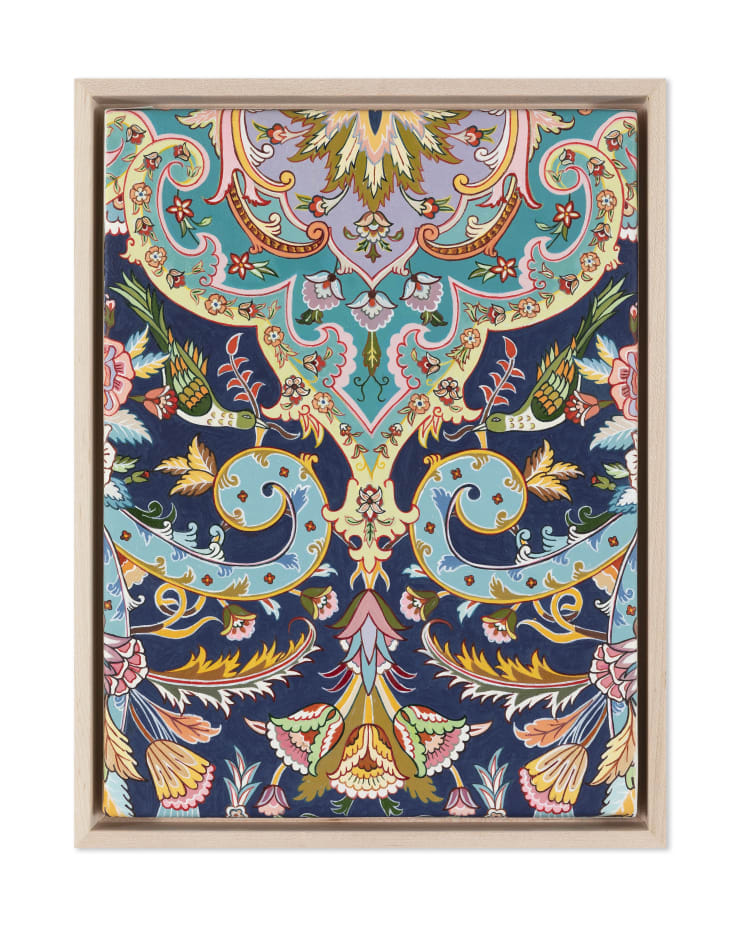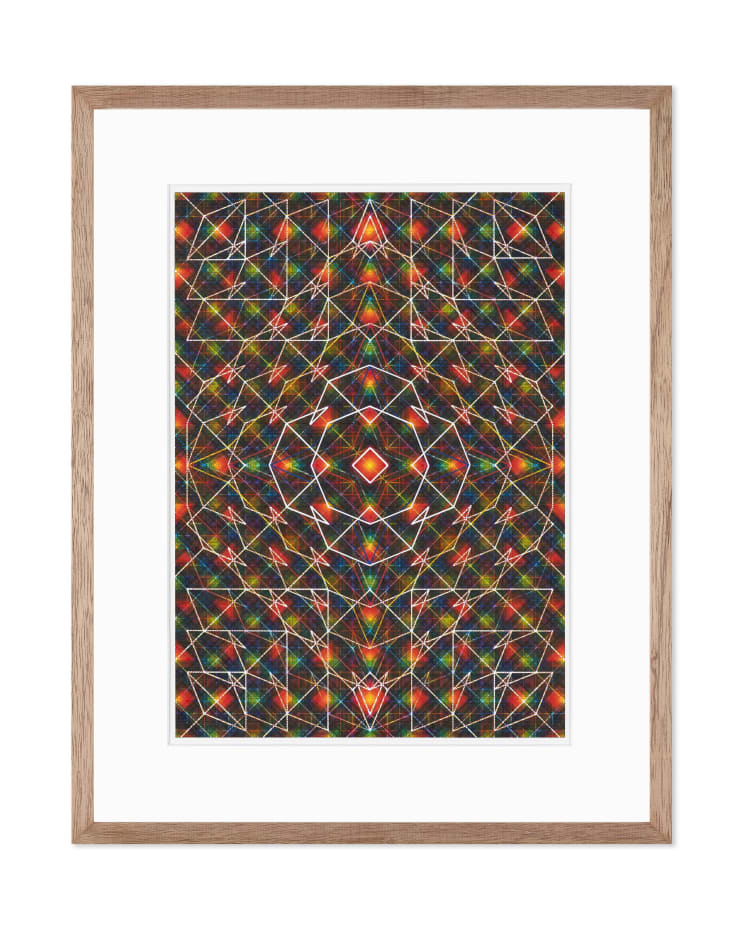-
Nima Nabavi and Jason Seife
Duality
-
The Third Line is pleased to announce Duality, featuring new works by artists Nima Nabavi and Jason Seife. Duality is a showing of two artists working together in symbiosis, a product of an enduring "art friendship". In ways both literal and metaphorical, the exhibition is a way of putting pen to paper on developments that were organically occurring when two artists who share a particular way of seeing collide.
-
Duality: Nima Nabavi and Jason Seife
Dr Natasha Morris -
-
 Nima Nabavi, Civic, 2023, Archival ink on canvas, 92.2 x 94.4 x 5 cm, framed
Nima Nabavi, Civic, 2023, Archival ink on canvas, 92.2 x 94.4 x 5 cm, framed -
-
 Jason Seife, Civic, 2023, Oil and Acrylic on Canvas, 94.5 x 94.7 x 5 cm, framed
Jason Seife, Civic, 2023, Oil and Acrylic on Canvas, 94.5 x 94.7 x 5 cm, framed -
-
"It entails a tangible sense of mutual respect and the deep knowing of someone else which extends, at its most intimate, into the anticipation of their next move. What results is a symbiosis that becomes a pas de deux."
Up close, the detail is rich and even more complex than either artist had attempted before. There is a subtlety of matching elements in response to one another. There may be a corner of blue, or a hexagon of orange, that at once appears bold as brass to Seife’s eye that becomes a gauzy layering of tones in Nabavi’s execution. Ultimately, they work in very different mediums, and although they may mirror one another structurally, the works retain the tell-tale idiosyncrasies of their maker’s approach. Seife’s work is bold in its flatness and opacity, with pools of pure colour and satisfyingly smooth outlines crafted in a way that is resoundingly painterly. There is room for plenty of tension, perhaps, in these juxtapositions, but in keeping each work’s independence they avoid direct conflict. Working in tandem like this is hugely revealing. It entails a tangible sense of mutual respect and the deep knowing of someone else which extends, at its most intimate, into the anticipation of their next move. What results is a symbiosis that becomes a pas de deux.
-
 Nima Nabavi, Level, 2023, 2023, Archival ink on canvas, 189 x 79.2 x 5 cm, framed
Nima Nabavi, Level, 2023, 2023, Archival ink on canvas, 189 x 79.2 x 5 cm, framed -
-
 Jason Seife, Level, 2023, 2023, Oil and acrylic on canvas, 190.5 x 78.5 x 5 cm, framed
Jason Seife, Level, 2023, 2023, Oil and acrylic on canvas, 190.5 x 78.5 x 5 cm, framed -
-
 Nima Nabavi, Radar, 2023, Archival ink on canvas, 84 x 95 x 5 cm
Nima Nabavi, Radar, 2023, Archival ink on canvas, 84 x 95 x 5 cm -
-
 Jason Seife, Radar, 2023, Oil and Acrylic on Canvas, 83.2 x 95 x 5 cm
Jason Seife, Radar, 2023, Oil and Acrylic on Canvas, 83.2 x 95 x 5 cm -
-
The middle void, a white-hot pin within the irradiated braids of colour, was a way to work together on the centre as the generative and anchoring point of departure; this solved not only the issue of who would begin the piece but cultivated a working method akin to a trust exercise. Without the central point, Nabavi and Seife were forced outside their respective comfort zones of creation: there was no compass point of sunburst shamseh medallion of a carpet to work around. Both practically and symbolically, in Noon each half must lean on the other to create the middle.
This dichotomy between freedom and discipline that accountability and exchange create has pushed each artist to evolve. This was the first time Seife had taken away the foundational anchors and borders from his work. The growth and expansion of his approach to pattern and composition, geometry, and design has been developed significantly from working so close to Nabavi’s precision. On the other hand, Nabavi found himself compelled to work beyond the logical limits of the rainbow spectrum. As natures inherent prism, it had been the palette of his work in its most pure iterations. Working with Seife even had him looking at his family’s Persian carpets anew: there was a wildness of tonal companions, unexpected combinations, and fields of colour – complimentary or clashing, harmonious and discordant, deep versus light – that in turn encouraged him to let go of familiar or immediately appealing colourways. Collaboration was perhaps the natural next step for both to take. A dual exhibition was the culmination of a process that had already been burgeoning since their first initial contact, where the suggestive seeds of trying different papers, colours, and compositional combinations on each other’s recommendations were beginning to germinate. In ways both literal and metaphorical, the exhibition is a way of putting pen to paper on developments that were organically occurring when two people who share a particular way of seeing collide.
Such lessons in compositional chemistry are already being applied in the production of new works, with both artists approaching changes in medium, scale and shape with fresh eyes and ready hands. What will endure most, perhaps, for both the makers and viewers of these pieces, is the idea of tapping into someone else’s idea of the infinite whilst working on your own.
-
-
-
 Nima Nabavi and Jason SeifeNoon, 2023Archival ink, oil and acrylic on canvas158.75 x 158.75 cm
Nima Nabavi and Jason SeifeNoon, 2023Archival ink, oil and acrylic on canvas158.75 x 158.75 cm -
 Nima NabaviTenet, 2023Archival ink on canvas88.9 × 177.8 cm
Nima NabaviTenet, 2023Archival ink on canvas88.9 × 177.8 cm -
 Jason SeifeTenet, 2023Oil and acrylic on canvas88.9 x 177.8 cm
Jason SeifeTenet, 2023Oil and acrylic on canvas88.9 x 177.8 cm -
 Nima NabaviCivic, 2023Archival ink on canvas89.8 x 91.8 cm
Nima NabaviCivic, 2023Archival ink on canvas89.8 x 91.8 cm -
 Jason SeifeCivic, 2023Oil and acrylic on canvas92.1 x 92.4 cm
Jason SeifeCivic, 2023Oil and acrylic on canvas92.1 x 92.4 cm -
 Nima NabaviLevel, 2023Archival ink on canvas76.2 x 181.45 cm
Nima NabaviLevel, 2023Archival ink on canvas76.2 x 181.45 cm -
 Jason SeifeLevel, 2023Oil and acrylic on canvas181.45 x 76.2 cm
Jason SeifeLevel, 2023Oil and acrylic on canvas181.45 x 76.2 cm -
 Nima NabaviRadar, 2023Archival ink on canvas91.44 x 79.2 cm
Nima NabaviRadar, 2023Archival ink on canvas91.44 x 79.2 cm -
 Jason SeifeRadar, 2023Oil and acrylic on canvas91.44 x 79.2 cm
Jason SeifeRadar, 2023Oil and acrylic on canvas91.44 x 79.2 cm -
 Jason SeifeUntitled 1, 2023Oil and acrylic on canvas31.75 x 31.75 cm
Jason SeifeUntitled 1, 2023Oil and acrylic on canvas31.75 x 31.75 cm -
 Jason SeifeUntitled 2, 2023Oil and acrylic on canvas31.75 x 31.75 cm
Jason SeifeUntitled 2, 2023Oil and acrylic on canvas31.75 x 31.75 cm -
 Jason SeifeUntitled 3, 2023Oil and acrylic on canvas24.13 x 31.75 cm
Jason SeifeUntitled 3, 2023Oil and acrylic on canvas24.13 x 31.75 cm -
 Jason SeifeUntitled 4, 2023Oil and acrylic on canvas24.13 x 31.75 cm
Jason SeifeUntitled 4, 2023Oil and acrylic on canvas24.13 x 31.75 cm -
 Jason SeifeUntitled 5, 2023Oil and acrylic on canvas24.13 x 31.75 cm
Jason SeifeUntitled 5, 2023Oil and acrylic on canvas24.13 x 31.75 cm -
 Jason SeifeUntitled 6, 2023Oil and acrylic on canvas16.51 x 16.51 cm
Jason SeifeUntitled 6, 2023Oil and acrylic on canvas16.51 x 16.51 cm -
 Jason SeifeUntitled 7, 2023Oil and acrylic on canvas16.51 x 16.51 cm
Jason SeifeUntitled 7, 2023Oil and acrylic on canvas16.51 x 16.51 cm -
 Nima Nabavi2023.05.17, 2023Archival Ink on panel28.57 x 28.57 cm
Nima Nabavi2023.05.17, 2023Archival Ink on panel28.57 x 28.57 cm -
 Nima Nabavi2023.05.21, 2023Archival ink on paper46.99 x 40.64 cm
Nima Nabavi2023.05.21, 2023Archival ink on paper46.99 x 40.64 cm -
 Nima Nabavi2023.07.12, 2023Archival ink on panel28.57 x 28.57 cm
Nima Nabavi2023.07.12, 2023Archival ink on panel28.57 x 28.57 cm -
 Nima Nabavi2023.07.14, 2023Archival ink on panel28.57 x 28.57 cm
Nima Nabavi2023.07.14, 2023Archival ink on panel28.57 x 28.57 cm -
 Nima Nabavi2023.07.15, 2023Archival ink on paper28.57 x 28.57 cm
Nima Nabavi2023.07.15, 2023Archival ink on paper28.57 x 28.57 cm -
 Nima Nabavi2021.03.14, 2021Acrylic on canvas33.02 x 33.02 cm
Nima Nabavi2021.03.14, 2021Acrylic on canvas33.02 x 33.02 cm -
 Nima Nabavi2022.05.07, 2022Archival ink, acrylic on paper39.37 x 49.53 cm
Nima Nabavi2022.05.07, 2022Archival ink, acrylic on paper39.37 x 49.53 cm -
 Nima Nabavi2022.06.08, 2022Ink on tracing paper40.01 x 55.88 cm
Nima Nabavi2022.06.08, 2022Ink on tracing paper40.01 x 55.88 cm
-
-
About Nima Nabavi
Born in Iran in 1978, Nima Nabavi is a self-taught Iranian-American artist who was raised in the United Arab Emirates.
Even though he received his undergraduate and graduate degrees in Business and was an independent business owner for 20 years – he unexpectedly changed paths in 2016 inspired by the geometric art of his late grandfather. He is now based in Dubai, where he dedicates himself to an art practice driven by a mathematical approach and a contemplative execution of intricate geometries.
Selected solo exhibition include; Visiting, Roswell Museum, New Mexico, USA (2023); 1,2,3, The Third Line, Dubai, UAE (2018). Selected group exhibitions include; Geometry and Art in The Modern Middle East, Misk Art Institute Jeddah, Saudi Arabia (2023); Sharjah Islamic Arts Festival – ‘Graduate’, Sharjah Museum of Art, Sharjah, UAE (2022); Ways of Seeing Abstraction - Works from the Deutsche Bank Collection, Palais Populaire, Berlin, Germany (2021); There is Fiction In The Space Between, The Third Line, Dubai, UAE (2020); Crafting Geometry: Abstract Art from South and West Asia, Sotheby’s, New York, USA (2020); Fragments, Yesterday and Today, Gateway, Abu Dhabi Art, Abu Dhabi, UAE (2019); Your Favorite Artist's Favorite Artist #2, Joshua Liner Gallery, New York, USA (2019); Horizon, Sharjah Islamic Arts Festival, Sharjah, UAE (2018).
Nima's work is part of private and public collections, including the Deutsche Bank Collection, Berlin, Germany and the Jameel Arts Centre, Dubai, UAE.
-
About Jason Seife
The intricate patterns of traditional Persian carpets and arabesques formed lasting childhood memories for Seife, who was born to immigrant parents from Syria and Cuba. Seife meticulously hand paints his own original designs. Despite being inspired by tradition, he makes use of unconventional materials such as reinforced concrete, allowing his work to be appreciated by broader audiences. Yet, the historical significance behind the work remains particularly important to Seife who admires the ability of traditional weavers to incorporate hidden meaning in their designs. These ancient designs were able to link to specific cultural identities, geographies and communities. Seife has followed in these footsteps, creating his own concealed language. The colours and patterns he uses are reflections of his own mood, relating to his emotional state of mind.
Selected solo exhibition include; Coming to Fruition, Pérez Art Museum Miami, US (2023); Generascope, Tabari Art Space, in collaboration with ICD Brookfield Place, Dubai, UAE (2022); Carlo Bilotti Museum, Rome, Italy (2022). Selected group exhibitions include; Traditions Interrupted, Museum of Texas Tech University Lubbock, TX (2023); Traditions Interrupted, Katonah Museum of Art Katonah, NY (2022); Beyond Borders, Unit London, UK (2019).
-
About Dr Natasha Morris
Dr Natasha Morris is Lecturer in Islamic Arts at The School of Oriental and African Studies (SOAS), University of London. She received her PhD in the art of Qajar Iran from The Courtauld Institute of Art, from where she also holds an MA and BA. She was previously Myojin-Nadar Project Curator Middle East Art at the British Museum, and has written extensively on the arts of the Middle East and North Africa for a number of publications, including The Oxford Art Journal, The Art Bulletin, Time Out and The Guardian.
